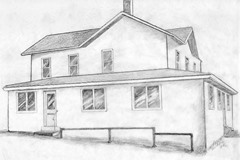Keep your furnace filter in mind this spring as you start the new season! Shane, an HVAC professional, sits down with Keith Specialty to share how homeowners can cut down on costly emergency call-outs and keep their furnace running better, longer.
Proper furnace filter maintenance (and how it can save you money)

As an HVAC repairman, I fix and tune-up furnaces of all shapes, ages and conditions. Furnaces shut down for many reasons, some due to normal wear-and-tear and some due to more complicated problems. What is surprising to me is that one out of every five emergency calls I respond to has a very simple solution: I change the dirty filter.
The one thing that you as a homeowner can do to aid in the longevity of your furnace is to regularly change the furnace filter. It’s recommended that, at minimum, filters be changed quarterly. If everything is sized correctly, the furnace should give you a good 15-20 years; however, I’ve seen dirty filters take out a furnace in 12 years.
I’ve pulled filters out that look like rug mats. A good rule of thumb for homeowners questioning when their filter needs to be changed is to use the eye test. Hold the filter up to the light and if you can’t see light passing through it, then it’s time to change it. If light can’t pass through the filter then you can bet that air will have trouble too.
What a furnace filter is for
The purpose and importance of a furnace filter is often misunderstood. A lot of people tend to believe that the furnace filter is there to clean the environment, collect the dust and keep it from being dispersed throughout the living space. However, the primary job of the furnace filter is to protect the furnace itself and its components. Just like the air filter in your vehicle cleans the intake air to protect the environment the air enters (the carburetor).
As a result of this misunderstanding, many people gravitate towards furnace filters that are too restrictive. The number one cause of premature failure or early death of a furnace is lack of airflow supplying the furnace, which is directly related to its filter performance.
How improper air flow can shut your furnace down
Your return duct is what supplies the furnace with the air. Your furnace then heats, or air conditioner cools, and disperses the air throughout the environment to keep it comfortable (condition the air, as we call it in the industry). Restricted airflow puts more stress on your motor, causing it to draw more power. This can cause premature wear and tear on the motor, causing it to burn up – a very expensive fix. It can also cause a capacitor to go bad early because it’s working too hard to provide the motor the extra boost it needs to move the required amount of air.
Any of these factors can shut down the furnace, throw it into a lockout state and make it fail to operate. A lot of times it’s a temporary inoperation. Most modern furnaces have built-in safeties to accommodate for restricted airflow, so if it senses something is going wrong it will shut down the operation of the furnace until a technician goes to repair it. Probably 20% of the time when I get called out for a repair of that nature, the fix is simply changing the filter and then watching the furnace operate for a little while to make sure that was the proper corrective action.
How fragile is airflow?
Every furnace, when built, is built to a predetermined specification of what we call external static pressure. Bends in ductwork, various registers being closed and dampers all have an effect on external static pressure reading. Most furnaces are rated somewhere around ½ inch of water column which, for relation, is the amount of pressure it takes to suck a liquid through a straw. Not very much pressure at all.
We can measure external static pressure using a tool called a manometer. Various types of filters restrict the airflow from the get-go. There’s MERV (Minimum Efficiency Reporting Value) ratings on filters as well as other types of ratings that tell you they’re going to reduce bacteria or some other marketing scam, in my opinion. What most of these filters are actually doing is restricting airflow to the furnace. Yes, they protect the furnace from dust and debris, but they ruin the furnace over time by restricting the amount of airflow the furnace can access. There is a fine balance between screening the furnace and choking it.
What’s happening inside the furnace when airflow is restricted is that the heat exchanger rapidly heats up to the point that the fan cycles on, based on a series of limit switches within the circuitry. The fan is told to cycle on because the heat exchanger is too hot. If it can’t remove that heat efficiently enough, the furnace combustion process stops until the fan removes the heat. It’ll do this multiple times an hour. Too many cycles off and on will obviously cause premature wear. When the furnace reaches what is called high limit and it cycles too many times within an hour it can go into a soft lockout state, which most generally leads to a callout to a technician.
Things like a dirty blower wheel can cause a rise in external static pressure and limit the amount of air that the furnace is able to move across the heat exchanger and the coil. Dirty filters can also have a detrimental effect in the cooling season. If the airflow is restricted, your evaporator coil will freeze over because it can’t efficiently absorb and remove the heat in the house. It becomes restricted and will freeze over causing evaporator coil overflows and a number of other problems.
Make a plan to change your furnace filter
I can’t stress enough the importance of changing your filters and performing regular furnace maintenance. It’s one of the few things that you as a homeowner can directly affect. Replacement filters are low in cost and a proper maintenance schedule can definitely prevent high-cost call-outs late at night or on the weekend.
Check out furnace filters from Keith Specialty
More on why changing furnace filters is important (Energy Vanguard)
More on why changing air conditioner filters is important (Energy.gov)

